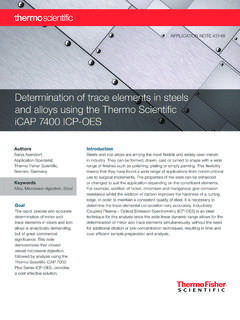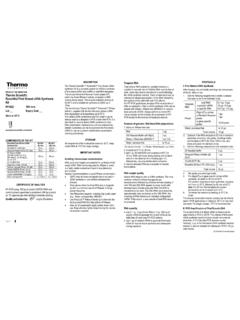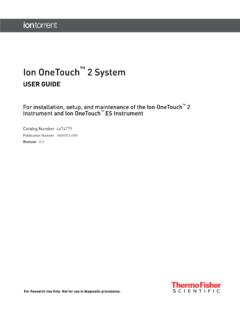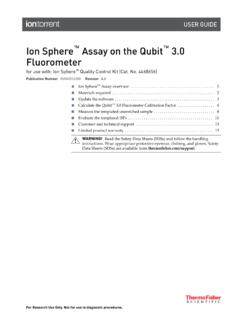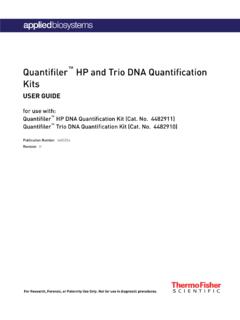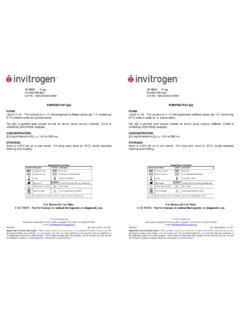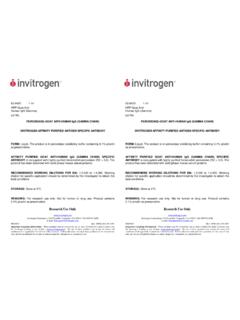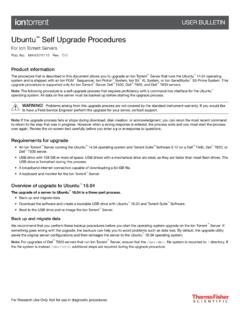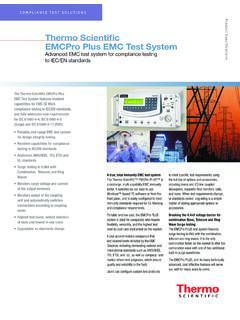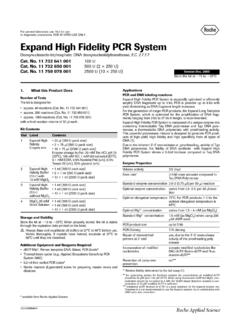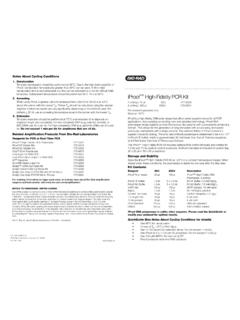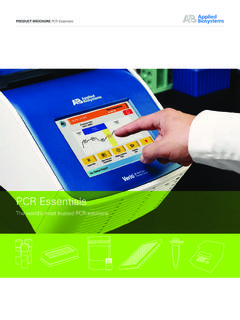Transcription of PRODUCT INFORMATION Thermo Scientific High-Fidelity …
1 PRODUCT INFORMATION . Thermo Scientific Phusion High-Fidelity PCR Kit Pub. No. MAN0013363. Rev. Date 27 June 2018 (Rev. ). #_. Lot _ Expiry Date _. Store at -20 C. For Research Use Only. Not for use in diagnostic procedures. 2. COMPONENTS OF THE KIT. #F-553S #F-553L. Component 50 rxns 200 rxns Phusion DNA Polymerase, 2 U/ L 25 L 100 L. 5X Phusion HF buffer 1 mL 3 mL. 5X Phusion GC buffer 1 mL 1 mL. dNTP mix, 10 mM each 100 L 400 L. 50 mM MgCl2 solution mL mL. Control lambda template, ng/mL 40 L 40 L. kb primers, 4 M each 50 L 50 L. 10 kb primers, 4 M each 50 L 50 L. DNA size standard 200 L 400 L. DMSO mL mL. 1. INTRODUCTION. Thermo Scientific Phusion High-Fidelity DNA Polymerase offers extreme performance for all major PCR applications.
2 Incorporating an exciting technology, Phusion DNA Polymerase brings together a novel Pyrococcus-like enzyme with a processivity-enhancing domain. Phusion DNA Polymerase generates long templates with an accuracy and speed previously unattainable with a single enzyme, even on the most difficult templates. The extreme fidelity makes Phusion DNA Polymerase a superior choice for cloning. The error rate of Phusion DNA. Polymerase in Phusion HF Buffer is 10-7 when determined with a modified lacI-based method1. It is approximately 50-fold lower than that of Thermus aquaticus DNA polymerase and 6-fold lower than that of Pyrococcus furiosus DNA polymerase.
3 The Phusion High-Fidelity PCR Kit includes lambda DNA control template and primers for kb and 10 kb amplicons. The template amount is sufficient for performing 20 control reactions in 50 L volume or 50 control reactions in 20 L volume. 2. IMPORTANT NOTES. Use 98 C for denaturation (see and ). The annealing rules are different from many common DNA polymerases (such as Taq DNA. polymerases). Read section carefully. Use 15 30 s/kb for extension. Do not exceed 1 min/kb (see ). Use Phusion DNA Polymerase at 1 U per 50 L reaction volume. Do not exceed 2 U/50 L (see ). Use 200 M of each dNTP. Do not use dUTP (see ). Note: Phusion DNA Polymerases produce blunt end PCR products.
4 3. 3. GUIDELINES FOR PHUSION DNA POLYMERASE. Phusion DNA Polymerase (2 U/ L) is provided with 5X Phusion HF Buffer and 5X Phusion GC. Buffer. Both buffers contain mM MgCl2 at final reaction concentrations. Separate tubes of DMSO and 50 mM MgCl2 solutions are provided for further optimization. Basic reaction conditions for DNA amplification Carefully mix and centrifuge all tubes before opening to ensure homogeneity and improve recovery. PCR reactions should be set up on ice. Phusion DNA Polymerase should be pipetted carefully and gently as the high glycerol content (50%) in the storage buffer may otherwise lead to pipetting errors. It is critical that Phusion DNA Polymerase is the last component added to the PCR mixture, since the enzyme exhibits 3 5 exonuclease activity that can degrade primers in the absence of dNTPs.
5 Due to the nature of Phusion DNA Polymerase, the optimal reaction conditions may differ from PCR protocols for standard DNA polymerases. Due to the high salt concentration in the reaction buffer, Phusion DNA Polymerase tends to work better at elevated denaturation and annealing temperatures. Please pay special attention to the conditions listed in section 5 when running your reactions. Following the guidelines will ensure optimal enzyme performance. Table 1. Pipetting instructions (add items in this order). Component 50 L rxn 20 L rxn Final conc. H2O add to 50 L add to 20 L. 5X Phusion HF Buffer* 10 L 4 L 1X. 10 mM dNTPs 1 L L 200 M each Primer A** X L X L M.
6 Primer B** X L X L M. Template DNA X L X L. (DMSO**, optional) L L 3%. Phusion DNA Polymerase L L U/ L. * Optionally 5X Phusion GC Buffer can be used, see section for details. ** The recommendation for final primer concentration is M, but it can be varied in the range of M, if needed. ** Addition of DMSO is recommended for GC-rich amplicons. DMSO is not recommended for amplicons with very low GC % or amplicons that are >20 kb. Table 2. Cycling instructions 2-step protocol 3-step protocol Cycle step Cycles Temp. Time Temp. Time Initial denaturation 98 C 30 s 98 C 30 s 1. Denaturation 98 C 5-10 s 98 C 5-10 s Annealing - - X C 10-30 s (see ) 25-35.
7 Extension (see ) 72 C 15-30 s/kb 72 C 15-30 s/kb 72 C 5-10 min 72 C 5-10 min Final extension 1. 4 C hold 4 C hold 4. 4. NOTES ABOUT REACTION COMPONENTS. Enzyme The optimal amount of enzyme depends on the amount of template and the length of the PCR. PRODUCT . Usually 1 unit of Phusion DNA Polymerase per 50 L reaction volume gives good results, but optimal amount can range from to 2 units per 50 L reaction depending on amplicon length and difficulty. Do not exceed 2 U/50 L ( U/ L), especially for amplicons that are >5kb. When cloning fragments amplified with Phusion DNA Polymerase, blunt end cloning is recommended. If TA cloning is required, it can be performed by adding A overhangs to the blunt PCR PRODUCT with Thermo Scientific Taq DNA Polymerase, for example.
8 However, before adding the overhangs it is very important to remove all the Phusion DNA Polymerase by purifying the PCR PRODUCT carefully. Any remaining Phusion DNA Polymerase will degrade the A overhangs, creating blunt ends again. Buffers Two buffers are provided with the enzyme: 5X Phusion HF Buffer (F-518) and 5X Phusion GC. Buffer (F-519). The error rate of Phusion DNA Polymerase in HF Buffer ( 10-7) is lower than that in GC Buffer ( 10-7). Therefore, the HF Buffer should be used as the default buffer for High-Fidelity amplification. However, GC Buffer can improve the performance of Phusion DNA Polymerase on some difficult or long templates, such as GC-rich templates or those with complex secondary structures.
9 For applications such as microarray or DHPLC, where the DNA templates need to be free of detergents, detergent-free reaction buffers (F-520, F-521) are available for Phusion DNA Polymerases. Mg2+ and dNTP. The concentration of Mg2+ is critical since Phusion DNA Polymerase is a magnesium dependent enzyme. Excessive Mg2+ stabilizes the DNA double strand and prevents complete denaturation of DNA. Excess Mg2+ can also stabilize spurious annealing of primers to incorrect template sites and decrease specificity. Conversely, inadequate Mg2+ may lead to lower PRODUCT yield. The optimal Mg2+ concentration also depends on the dNTP concentration, the specific template DNA and the sample buffer composition.
10 In general, the optimal Mg2+. concentration is to 1 mM over the total dNTP concentration for standard PCR. If the primers and/or template contain chelators such as EDTA or EGTA, the apparent Mg2+ optimum may be shifted to higher concentrations. If further optimization is needed, increase Mg2+. concentration in mM steps. high quality dNTPs should be used for optimal performance with Phusion DNA Polymerase. The polymerase cannot read uracil derivatives or inosine in the template strand so the use of these analogues or primers containing them is not recommended. Due to the high processivity of Phusion DNA Polymerase there is no advantage in increasing dNTP concentrations.
